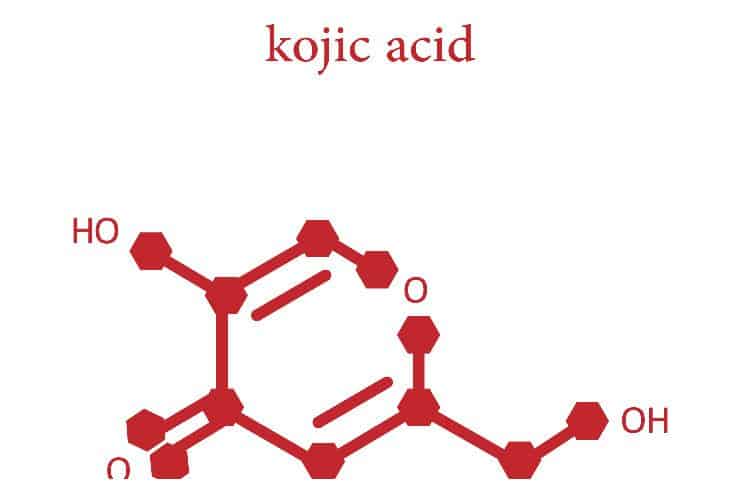Kojic Acid vs Hydroquinone – detailed comparison:
Kojic Acid
It is a chelation agent produced by a few species of fungi, particularly Aspergillus oryzae, that has the Japanese common name koji. Industrial production is restricted to filamentous fungi. Also, it is a by-product of fermented soy sauce and rice wine.
This substance was discovered in Japan in 1989 and is used both in cosmetics and Japanese cuisine.
Mechanism of Action
It works by blocking tyrosine from forming, which then prevents melanin production. Melanin is the pigment that affects skin, hair, and eye color. A decreased melanin production may have a lightening effect on the skin.
Uses
Cosmetics that contain kojic acid are used to reduce skin problems, such as – freckles, melasma, and hyperpigmentation. It also helps with skin problems, like – pimples, psoriasis, dark spots, and acne scars.
Moreover, it is classified as an antioxidant. This class of nutrients has the capacity to counteract the negative effects of free radicals, that have the potential to cause oxidative damage to the skin cells.
This substance is also believed to have some antifungal properties. It may be helpful in treating and preventing certain fungal infections, like – yeast infections and athlete’s foot.
Side Effects
High concentrations of kojic acid may cause kidney, liver, cardiovascular, reproductive, respiratory, and gastrointestinal side effects in animals, according to a study by the non-profit Environmental Working Group.
Contact dermatitis is another side effect of cosmetics that have kojic acid. Contact dermatitis is a red, itchy rash caused by direct contact with a substance or an allergic reaction to it.
Tips
Adding topical corticosteroids to kojic acid creams can substantially reduce the risk of contact dermatitis. Also, the use of KA with aloe vera can minimize the risk of skin sensitivity.
Some studies concluded that kojic acid used in cosmetics is safe as long as the product density does not exceed 2 percent concentration.
This substance has the tendency to oxidize over time, therefore, using vitamin E tocopherol in the cream may reduce oxidation.
Because KA reduces the amount of melanin in your skin, you actually reduce your natural defense from the sun. Therefore, it is essential to protect your skin from the sun while using products containing kojic acid.
Hydroquinone
It is an ingredient in creams used to lighten discolorations of the skin.
Mechanism of Action
This substance works by decreasing the production and increasing the breakdown of melanosomes in the skin’s pigment cells. It does this by inhibiting the activity of tyrosinase, one of the key enzymes in mammalian melanin synthesis.
Uses
Hydroquinone topical is used to lighten areas of darkened skin, like – age spots, freckles, chloasma (darkened skin caused by hormonal changes), or melasma (sun damage).
Tips
Most people who use hydroquinone cream notice a change in the discolored skin within 21 days when using the cream two times per day.
It is recommended that you only use products containing this ingredient for a maximum of 3 months and then stop using them for at least 3 months. However, when you discontinue the use of these cosmetics, your skin’s natural supply of tyrosinase will no longer be inhibited, and slowly your skin’s natural pigmentation will return.
Wash your hands before and after applying products containing this medicine, unless you are using it to treat the skin on your hands.
Do not use this ingredient on open wounds or on windburned, sunburned, or irritated skin. Avoid exposure to sunlight or tanning beds since it can make you sunburn more easily.
READ MORE: Ketoconazole vs Clotrimazole
Side Effects
Side effects may include:
- dry skin;
- blisters or sores;
- skin irritation;
- itching;
- redness;
- swelling of the mouth, face, lips, tongue, or throat;
- unusual hoarseness;
- trouble breathing;
- tightness in the chest or throat;
- exogenous ochronosis – a cutaneous disorder characterized by blue-black pigmentation. This side effect occurs with long-term use of hydroquinone.
Contraindications
Before using products containing this ingredient, tell your healthcare professional if you have:
- asthma;
- if you are using any antibiotic medicine;
- sulfite allergy;
- kidney disease;
- liver disease.
Alcohol
Avoid drinking alcoholic beverages while taking this medication since alcohol use can substantially increase the risk of side effects.
Pregnancy & Breastfeeding
There are no well-done studies to determine whether this medication is safe to use during pregnancy. Tell your healthcare provider that you are pregnant or plan to fall pregnant before using this medication.
It is not known exactly whether this medication passes into human breast milk or if it could negatively affect a breastfed infant. Tell your healthcare provider that you are breastfeeding a baby before using this medication.
READ MORE: Glipizide vs Januvia
Bottom Line – Kojic Acid vs Hydroquinone
Kojic acid is a compound that is typically derived from various fungi. It is used as a skin-lightening agent due to its effects on a protein known as tyrosinase.
Hydroquinone is an effective topical medicine that is used to treat freckles, dark-colored patches, and spots on the skin which appear due to hormonal changes, sun exposure, or aging.
The results of a 2013 study concluded that a 4 percent hydroquinone cream is a better topical hypopigmented agent with a rapid rate of clinical improvement when compared to 0.75 percent kojic acid cream.
However, kojic acid provides a safer alternative to hydroquinone, which can cause permanent damage to the skin by causing blue stains.
READ THIS NEXT: Vemlidy vs Viread
References https://www.sciencedirect.com/topics/agricultural-and-biological-sciences/ https://www.ncbi.nlm.nih.gov/pmc/articles/PMC3468271/ https://ec.europa.eu/health/scientific_committees/consumer_safety/docs/
